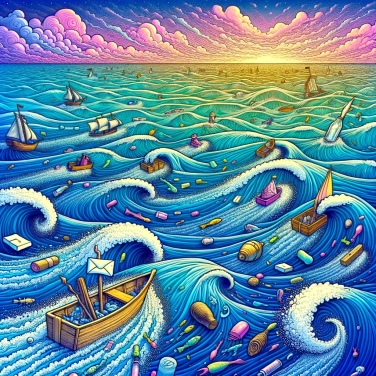Ocean currents transport objects over thousands of kilometers in the oceans due to the Coriolis force and differences in temperature and salinity of the waters, which influence ocean circulation.

Ocean currents are large movements of water that travel through the oceans much like immense underwater rivers. They are primarily created in two ways: either due to surface winds like the Gulf Stream, or by differences in temperature and salinity (this is called thermohaline circulation). Cold, saltier water is denser, sinking to the ocean floor, while warm water is lighter and remains at the surface. These interactions create a gigantic loop that constantly stirs the planet's oceans.
The rotation of the Earth also plays a role: it deflects currents to the right in the northern hemisphere and to the left in the southern hemisphere — this is the Coriolis effect, a direct consequence of our planet spinning continuously. As a result, currents often follow curved paths rather than straight ones. All this movement allows for the transport of objects — from lost plastic to floating bottles — over astonishing distances.
Basically, ocean transportation mainly depends on a few major natural mechanisms. Obviously, there is first the wind, which creates surface water movements capable of carrying all kinds of floating objects over huge distances. Next, differences in temperature and salinity play an important role: cold, salty water sinks to the ocean floor while warmer, lighter surface water circulates differently, forming a kind of immense marine conveyor belt: this is known as thermohaline circulation. Also essential is the effect of the Earth's rotation, called the Coriolis force, which slightly deflects currents to the right in the northern hemisphere and to the left in the southern hemisphere, giving currents their typically curved path. Finally, the shape of the coastlines and the underwater geography guide and modify the route of these drifting objects, causing them to travel even further.
Floating objects in the ocean drift mainly due to the combined action of ocean currents, surface winds, and the effect of waves. These elements push the objects — sometimes for thousands of kilometers — from the place where they fell into the water. Depending on their size, shape, or buoyancy, they can move quickly or slowly, follow a direct path, or meander for a long time. Small, lightweight objects like bottles or pieces of plastic are primarily influenced by the wind and therefore travel differently than a container or a massive piece of wood, which are more deeply submerged and pushed by stronger and more consistent currents. Some then find themselves caught in enormous oceanic whirlpools called gyres, and there, it can last a long time: they spin around, accumulate, and slowly disperse far from their point of origin.
Surprising objects sometimes travel across all oceans thanks to ocean currents. The Nike sneakers that escaped from a container that fell into the sea in 1990 off the North Pacific are a good example. For years, sports shoes floated, some discovered as far away as Alaska, Hawaii, or even Japan! More astonishing are the yellow plastic ducks that fell off a cargo ship into the Pacific Ocean in 1992. These toys drifted for nearly twenty years, reaching the shores of Europe, Australia, and even remote beaches in South America—helping scientists better understand ocean currents along the way. Another striking case is the debris from the 2011 tsunami in Japan, sometimes found years later on American beaches, including entire boats, buoys, pieces of houses, and even motorcycles. These examples clearly demonstrate the impressive power of currents capable of transporting just about anything over thousands of kilometers.
The objects transported by ocean currents unfortunately often end up creating floating masses of plastic waste, like the famous Great Pacific Garbage Patch. These wastes take an incredibly long time to disappear: a plastic bottle can take over 400 years to fully degrade. In the meantime, they poison marine life, as fish, birds, and marine mammals often confuse them with their usual food. Many animals swallow these plastics, causing internal injuries, choking, or death by starvation, as their stomachs become filled with indigestible materials. These same wastes also serve as improvised rafts for invasive species that travel to new ecosystems, disrupting local balances. Not to mention microplastics, these tiny pieces resulting from the gradual breakdown of waste, ingested by marine species, ultimately entering our food chain. It’s safe to say that our waste traversing the oceans impacts all marine biodiversity... and eventually us as well.
Thanks to drifting buoy systems equipped with GPS beacons, scientists regularly study the paths taken by ocean currents. Some of these buoys have revealed unexpected maritime routes, highlighting the complexity of ocean circulation.
Some marine organisms, such as jellyfish, naturally take advantage of ocean currents to travel long distances without expending much energy. This passive mode of movement contributes to their rapid dispersion and the colonization of new oceanic regions.
The Great Pacific Garbage Patch gathers around 1.8 trillion pieces of floating plastic, covering an area equivalent to three times the size of France. This impressive accumulation is a direct result of circular ocean currents known as gyres.
Plastic bottles can take anywhere from a few weeks to several hundred years to travel through the oceans. Some bottles tracked by researchers have crossed multiple ocean basins thanks to ocean currents, before washing up on beaches thousands of kilometers from their point of origin.
Yes, several international initiatives exist to study ocean drift, such as satellite observation programs, GPS tracking buoys, and computer modeling. Many scientific campaigns and NGOs are also involved in raising awareness about the issue of oceanic waste transport and its environmental consequences.
Even though scientists use sophisticated models to predict drifting trajectories, it is often impossible to accurately determine the exact location and precise time when an object will come ashore. Indeed, ocean currents, local weather conditions, and the physical characteristics of the objects strongly influence these trajectories, adding a significant amount of uncertainty.
Floating objects carried by ocean currents pose a serious ecological threat, especially when it comes to plastic waste. They directly impact marine life, which may mistake them for food or become entangled in them. Moreover, they can transport invasive species to remote and fragile areas, disrupting local ecosystems.
The speed of a drifting object is primarily affected by its shape, mass, buoyancy, and wind resistance, as well as the speed and direction of surface currents and winds. Other parameters such as salinity, temperature, and tides can also play an important role.
Objects can drift for several weeks, months, or even years, depending on the ocean currents they are subjected to, the initial location of their release into the ocean, and their buoyancy. Some famous cases, such as plastic toys that escaped from containers, demonstrate that these journeys can last for several decades.

0% of respondents passed this quiz completely!
Question 1/5